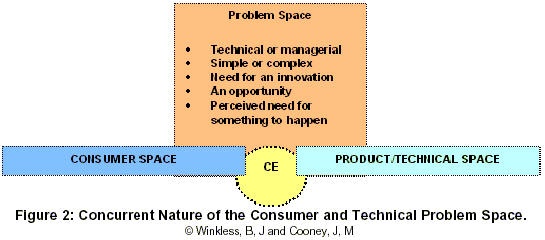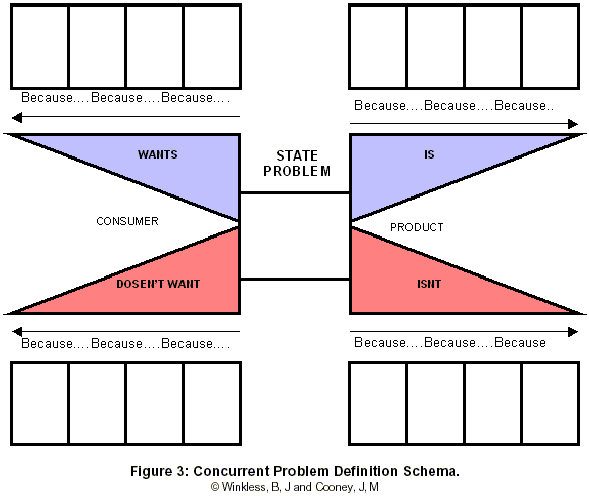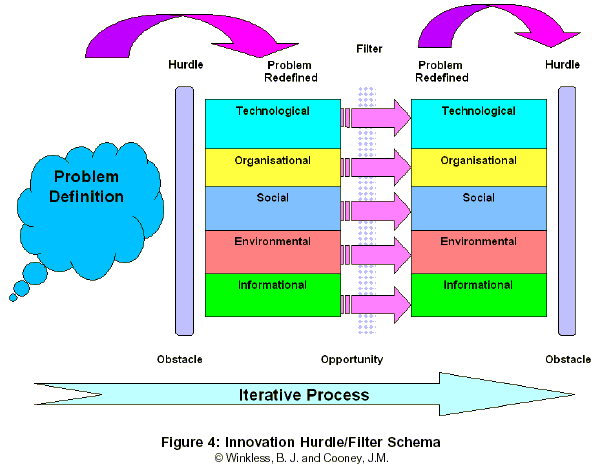Mapping the Innovation Space Part One: Novel Tools for Problem Definition in Product
Innovation.
By Barry Winkless Hdip, MSc & Dr. John Cooney
Abstract
The following article introduces and describes two novel problem definition tools. The tools include the Concurrent Problem Definition Tool, and the Innovation
Hurdle Filter System. The rationale behind the development of these tools is discussed.
Introduction
According to Romelaer (2000) the innovation process interacts with numerous
contexts and must be framed within these contexts. The various actions of which
the innovation process is composed must be co-ordinated with each other. The
firm must have competence and resources for each of the actions of which the
innovation process is composed.
To do this they need to have at their disposal innovative methodologies that
enable them to interact and learn from both within the system in which they
operate and also from external factors such as technological, organisational,
social, environmental, and intellectual influences.. In effect organisations need to
manage technical and economic environments. Padrao (2002) suggests that
successful innovations are linked to commercial value. Consequently any
innovation activity must ultimately lead to economic success.
The Move Towards Systemisation
One of the key tenets to an organisations success lies in the development of a
total systematic approach. According to Elfving et al., (2003:1) ‘success in
manufacturing requires continuous development and improvement of how
products are developed and produced. There is a need for new methods, tools
and procedures to improve product development especially due to increased
complexity and amount of relations between different actors.’ One of the main
drivers in this ‘Innovation Age’, is the identification of future consumer needs and
demands supported by innovative tools. To maintain this ‘innovation advantage’
organisations implement a number of methods suc h as concurrent engineering,
axiomatic design, value engineering, QFD, DFM and TRIZ. (TRIZ is a Russian acronym- literally -The
Theory of Inventive/Innovative Problem Solving.)
The Importance of Problem Definition
Problems experienced at the micro level can be the result of improper problem
definition at the macro level (Figure 1). Improper consumer product definition at
the macro level can often lead to product failure, even though the product has
met the technological criteria required. For example a product which is technologically sound can fail at the consumer (macro) level because it has been
designed for minimum handling rather that frequent handling through the value
chain. This highlights the overriding importance of 'rigorous' problem definition
well in advance of product development and commercialisation. The meso level
is the enabling link between the mciro and the macro levels to help sustain
competitiveness.
In TRIZ a ‘problem’ can be technical or managerial, simple or complex, a need
for innovation, an opportunity or a perceived need for something to happen.
These are expressed in terms of a problem definition. For example, the need for
a more comfortable chair is inherently a consumer need. Within the TRIZ
approach, however, a more comfortable chair is both a technical problem and a
market opportunity.
Essentially problem definition tools need to combine both the technical and
consumer aspects of innovation. Consequently the innovation process can be
enhanced by interfacing the existing innovation philosophies to create a more
robust problem definition methodology.
|
Macro Level | The Market, Usage, Organisational Structure, Environment, Social, Political |
| Meso Level | Competitivness, Education, Research, Technology Policy |
| Micro Level | Technology, Product Development, Process |
Figure 1: Elements of Macro and Micro Levels
The problem definition phase is a central activity in the innovation process. In the
context of problem definition information is analysed to define the most likely
‘cause of a problem’ or to ‘derive a solution’. Information needs to be gathered
in a systematic manner prior to formulating a problem statement. The information
gathered is critical and central to helping define the problem, diagnosing and
providing an accurate and faster solution to the problem. Moreover, both the
problem definition and information gathering should be used simultaneously in
order to achieve an accurate resolution.
Once sufficient information is gathered, a problem statement can be created to
define the problem in a specific, concise, and accurate manner. The
development of a robust problem statement makes it easier to focus and give
clarity to the problem and eliminates the risk of solving problems that do not fall
within the scope of the problem definition phase.
Rationale for a Concurrent Problem Definition Tool
Generally the process for solving a problem will consist of a sequence or
structure that fits together in order to ensure nothing is overlooked. Concurrent engineering philosophy is based on the integration of the engineering, marketing
and the voice of the consumer. Proulx (1996) suggests that CE is a ‘systematic
and multidisciplinary approach that simultaneously integrates the different
phases of product development and the management of its processes. These
processes include the identification of customer needs, specification of product
performance requirements, design of the product, manufacturing processes and
fabrication of the product, while considering the entire product life cycle,
including distribution, support, maintenance, recycling or disposal’.
Fundamentally, the key philosophy behind concurrent engineering is the
integration of both productionisation and commercialisation concerns in order to
achieve a successful product innovation.
In CE projects the voices of both internal and external customers are captured
and converted into specific predictable and measurable product characteristics
(Hales,1993). Any successful problem definition tool needs to be capable of
mapping both the technical and consumer innovation space (Figure 2).

Click here for larger image
Description of the Concurrent Problem Definition Tool
The concurrent problem definition tool (CPDT) maps both the product and
consumer space. It focuses on both the positive and negative aspects of the
consumer and product. This process is carried out in order to ensure that the
generic problem is mapped and defined in more specific terms.
The roadmap for utilising the CPDT is described below:
STEP 1
· State problem and enter into the CPDT problem space.
STEP 2
Map the Consumer Space
· Map from a consumer viewpoint. This should include needs and perceptions.
· Map from a generic to numerous more specific definitions.
· Use ‘because’ as a means to question consumer needs.
· Map both negative and positive aspects from the consumer view point.
· Phrase in ‘wants’ and ‘doesn’t want’ terminologies.
STEP 3
Map Product Space
· Map from a product view-point. This should include such factors as materials,
shape, colour, ergonomics system, sub-systems.
· Select a product benchmark. The product may ‘be your own’ or a competitors
product. It could also represent ‘best in class’.
· Map from one generic to numerous more specific definitions.
· Use ‘because’ as a means to question technical requirements.
· Map both positive and negative aspects from a technological perspective.
· Phrase in ‘is’ and ‘isnt’ terminologies.

Click here for larger image
Barriers and Obstacles to Innovation.
Braadland et al (2001) identify a number of innovation barriers for different
industry groups. These include economic risk, high costs, finance, organisational
rigidities, lack of qualified personnel, lack of IT, lack of market information,
regulations, standards and customer responsiveness. It is essential whilst
carrying out problem definition analysis that these type of generic obstacles or
hurdles to innovation are properly identified and mapped in order to maintain a
realistic perspective on what is achievable. Workshops carried out by the authors identified that people engaging in problem analysis have a tendency to
under estimate the importance of identifying the innovation hurdles that need to
be overcome in order to arrive at a solution for a specified problem. In this
regard they tended to adopt the traditional unsystematic brainstorming
approach, which is good for creative thought but not for focusing on innovation
within constraints.
Description of the Innovation Hurdle Filter System
The Innovation Hurdle Filter System (Figure 4) is used to map identified barriers
and hurdles within the system. Innovation hurdles can be technological:
organisational; political; social (personal, consumer); environmental or
informational. Furthermore, an organisation

Click here for larger image
may experience hurdles that affect: incentives for innovation such as short
compliance timeframes: sensitivity to incentives for example, culture of
compliance; idea formation such as employees do not appreciate benefits of
innovation; implementation for example product quality concerns (Scott et al.,
1998).
The hurdles mapped can then be analysed and filtered as to their potential
impact on the implementation of identified solutions. The system also enables us
to identify the hurdles that do not have an impact on the implementation of
identified solutions. The first step in using the Hurdle Filter System is to extract
one of the identified specific problems from the Concurrent Problem Definition tool. This specific problem is then entered into the Innovation Hurdle/Filter pro
forma.
It is recommended that a small cross functional group from different disciplines
carry out this phase of the problem definition process. This will ensure the cross
fertilisation of ideas and functions.
The group should focus on applying innovation hurdles to the problem definition.
This should enable the team to eliminate those hurdles that are not relevant to
further defining the problem space. It should also enable suggestions made by
the team members to be eliminated or selected for filtering to the next phase of
the problem definition process. This is an iterative process which when
exhausted will enable the team to better quantify and identify the problem space.
For each hurdle the 5W and 1 H questioning process should be applied in a
systematic manner:
1. What is the specific nature of the hurdle?
2. Why does this hurdle exist?
3. Where does the hurdle occur?
4. Who is causing the hurdle?
5. How can this hurdle be overcome?
6. When can we overcome this hurdle?
Future Work
The tools described represent part of a suite of novel mapping tools that can be
utilised in better defining the innovation space. Further articles will build on this
suite of tools and describe their application to actual case studies.
References:
Braadland, T.E., Ekland, A., (2001), ‘Innovation in Norwegian Industries-Testing
a New Taxonomy’. STEP Group.
Hales, R.F.,(1993), ‘QFD in Concurrent Engineering’, ProAction Development,
Inc. Web: www.proactdev.com/pages/qfdce.htm
Padrao, I., (2002), ‘Innovation Making it Happen, How to transform creativity and
new ideas into sustained competitive advantage’, Business Guide, CBI IBM
DEC.
Proulx, D.,(1996), ‘Concurrent Engineering, A new way to Introduce the
Engineering Profession to High School Students’, ASEE Annual Conference
Proceedings.
Romelaer, P., (2000), ‘Innovation and Management Constraints Working Paper’
no. 77, CREPA, University de Paris IX.
Scott, A., Lein, V.J., David, E.L., Downing, D.A., (1998), ‘Environmental
Innovation and Regulations: Shifting Reality from Rhetoric’, Main Report,
Department of Natural Resources, USA.
Copyright Winkless B, J & Cooney, J, M
This article originally appeared in the TRIZ journal. Barry Winkless is an expert in Triz innovation methods, as well as in Kano, QFD and DOE. He is a memeber of
the Global Coordination Group of ETRIA- the European Triz Innovation Association. Dr. John Cooney is an expert in Systems management and innovative management
practices. He is published extensively in this area and has also presented at
international conferences on systems approaches, innovative management
approaches. Both of the authors currently work for Altran Technologies Ireland.
Part Two of Mapping the Innovation Space will appear on MadeForOne.com soon.
|
